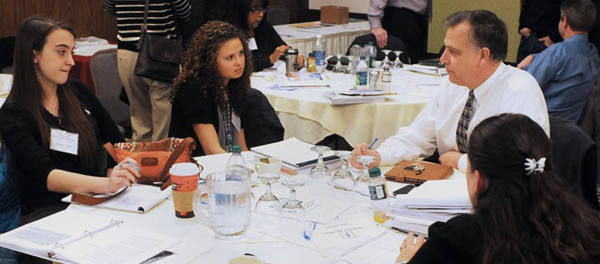

New safety messages to focus on transforming behavior
More than 30 people representing federal, state and local groups across Idaho recently participated in a workshop to develop a new communications strategy, "Positive Community Norms," that ITD hopes will reduce fatal car crashes.
Research scientist Jay Otto, with the Center for Health and Safety Culture at Montana State University (Bozeman), guided the group through the Positive Community Norms process to address impaired driving in Idaho.
Workshop participants learned how working within a framework of Spirit, Science and Action might lead to more effective communication efforts that focus on permanently transforming behavior and not just temporarily changing it. Specific attention was paid to closing the gaps between actual and perceived norms.
“The idea for the project originated from discussions between Mary Hunter (former highway safety manager) and Scott Stokes,” said Research Program Manager Ned Parrish. “Scott asked me to work with Mary to develop a proposal for a project that would be funded through the Research Program.”
A proposal was developed and submitted to ITD’s Research Advisory Council, which approved the project for funding in April 2010. Three proposals were submitted in response to the department’s request for proposals and Montana State’s center was selected.
 Survey work conducted by the University of Idaho’s Social Science Research Unit provided a starting point for the overall project, which is funded jointly by ITD’s Research Program and by the Office of Highway Safety.
Survey work conducted by the University of Idaho’s Social Science Research Unit provided a starting point for the overall project, which is funded jointly by ITD’s Research Program and by the Office of Highway Safety.
“In 2010, 209 individuals were killed and another 11,725 sustained serious injury in vehicular crashes on Idaho’s roadways,” said Highway Safety Manager Brent Jennings. “Besides the tragedy associated with vehicular crashes, the economic cost to Idaho was in excess of $2.4 billion. This equated to $1,577 for every Idahoan.”
The department is exploring this new approach to developing media messaging to engage the community.
“This process is called Positive Community Norms and it begins with connection, or a spirit, to the underlying meaning and values of highway safety,” Jennings explained. “This process continues with an examination of the science to understand the facts about highway safety and then concludes with strategies and actions the community engages in to eliminate death and injury on all roadways.”
Over the next five months, information provided by participants and data gathered by the center will be reviewed and messages and strategies developed for implementing the new plan.
As the center releases its findings, workshop participants were asked to remain involved and continue to help ITD develop its plan for reducing impaired driving in Idaho by providing feedback.
“The next steps involve summarizing the work captured at the Institute into an overall theme and conducting additional survey analysis, including recommended messages to close the gaps between the norms and perceived norms discovered,” said Deputy Director Scott Stokes.
A communication plan will be developed that takes into consideration the types of media to be used, the scope of the plan, and the available budget. Pilot testing of the messages should begin in about six to nine months. Recommendations for implementation and evaluation of the effort also will be proposed.
“The transportation department appreciates and thanks its workshop partners for the time and energy each has committed to this important safety work,” Stokes said. “More work is coming and ITD needs the continued involvement and commitment of its partners to ensure success.”
Photos: (Top) Deputy Director Scott Stokes and Lisa Losness, with Highway Safety brainstorm ideas with Boise High School students Vanessa McEntee and Kathryn Clifford (far left) during the workshop. (Right) Workshop facilitator Jay Otto walks workshop participants through the PCN process.
Published 3-9-2012